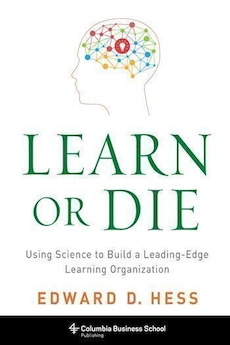By Tara Vasold Fischer
Learn or Die provides a blueprint for individual and organizational learning and success. Based upon the premise that consistent high performance is critically linked to high levels of employee engagement and organizational success, Edward D. Hess defines factors that cultivate an ability to strategically problem solve, challenging readers to take an active role in shaping the culture around them.
Oft ignored characteristics such as humility and servanthood are identified alongside passion and open mindedness as fundamental in the development of top leaders and managers according to the author. A strong argument for the power of emotional engagement in underlying all aspects of the success of an organization is a common theme throughout the book. Hess provides numerous examples, ranging from CEO’s of Fortune 500 companies to successful leaders within the world of scientific research on the forefront of technology. Strong leaders with the right characteristics and values, spurred by emotional passion for the work that is being done, will cultivate a good organizational learning environment.
This sounds simple enough, but what is a good organizational learning environment?
Hess analyzes extensive research and identifies the following characteristics, which must be present to foster such a place. A strong organizational learning environment promotes high levels of employee engagement. Such a learning environment also promotes positive emotions by encouraging learning by minimizing fear, ego defenses, complacency and arrogance. Critical policies that give employees the ability to take strategic risks are necessary. Employees must be empowered to speak freely. And, perhaps even more importantly, employees must be permitted to fail as long as the failure is within permissible conditions.
Learning, according to Hess, is a team sport.
Learn or Die challenges the reader to treat everything known as a hypothesis to be constantly retested by and with new data. The text describes learning as the perfect mix of science and art, combining the analysis of data with the knowledge gained through experiential learning or the knowledge that cannot be articulated but is part of what makes human beings unique and good at what they do. By combining both aspects of learning, individuals learn to think more holistically and see challenges through a different cognitive framework. Hess writes extensively on the topic of developing processes that allow people to think strategically and emphasizes that this is not a simple task. Fostering the ability to think strategically means that one is first able to identify the problems within what is being considered and then connect those problems to the right solutions.
Hess points to curiosity as a powerful trait that must be integrated into organizational processes and cultivated within employees. The author goes so far as to dare readers to ask themselves the question of “if you were replaced right now what would you hope your successor would do that you’re not doing?” Provocative questions such as this pepper the reading experience with moments of true reflection and cause the reader to pause and thoughtfully identify areas of personal weakness and opportunities for growth.
Learn or Die addresses four major themes:
- How people learn?
- What environmental factors enable or inhibit learning?
- What learning processes promote learning?
- How successful companies have operationalized the science of learning?
In Learn or Die, the right people + the right culture + the right processes = positive outcomes + the attainment of organizational goals.
Regardless of whether a manager or entry level employee, this text provides guidance on how to foster a positive and enduring culture of thinking beyond the status quo and achieving innovative results. As a business professional, Hess relies heavily on scholars from across the disciplines and from within numerous fields to support his ideas and provide meaningful illustrations. Learn or Die is well written and thoughtfully researched, but lacks the scientific tone that may have been expected by some readers. Despite this, Hess leaves no stone unturned and thoroughly dissects both apparent and unapparent scholarly connections in relation to learning at the individual and organizational level.
Learn or Die describes this level of constant learning as a mix of science and art and provides well researched data and provocative examples that will force readers to reflect on themselves and their organization, then take that discovery of oneself to the next level by providing actionable steps for internal and external learning acquisition. Hess brings together a vast array of cross disciplinary research and the experience of top organizations.
Learn or Die is a must read for those who are hoping to challenge their own realm of understanding and biases in order to build a top notch learning organization. This text will test the way one sees the world and encourage the reader to remove the cognitive lens that serves as a default deterrent to achieving learning within the individual and organization.
Tara Vasold Fischer, a Phi Beta Kappa member inducted at Dickinson College in 2002, is currently pursuing a master’s in Public Policy and Administration at Northwestern University.




